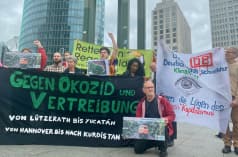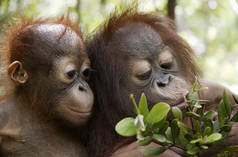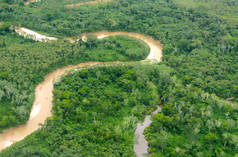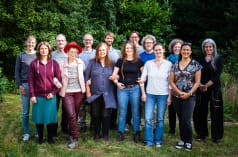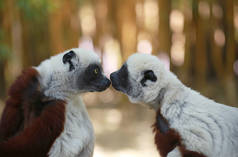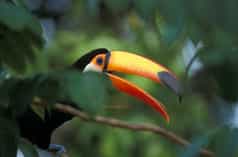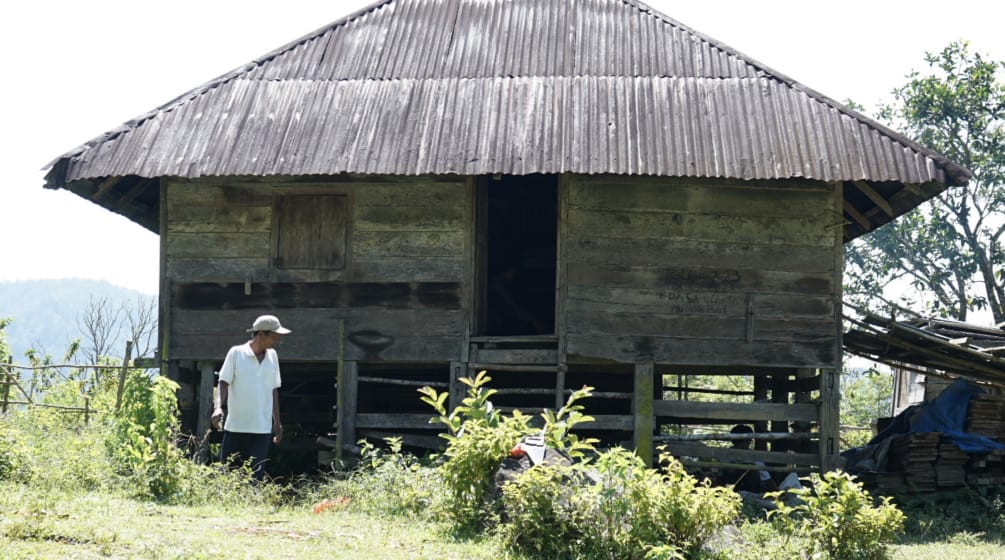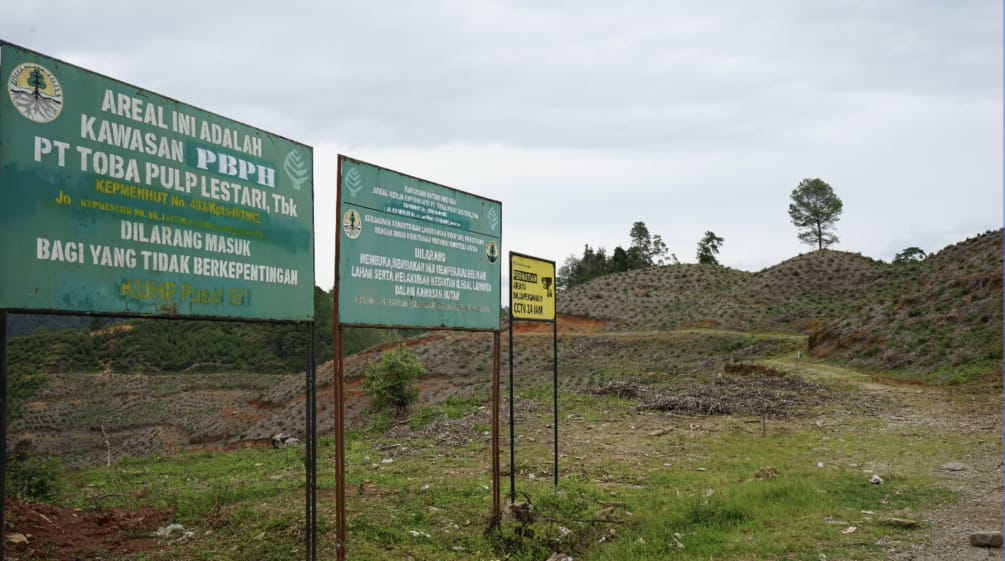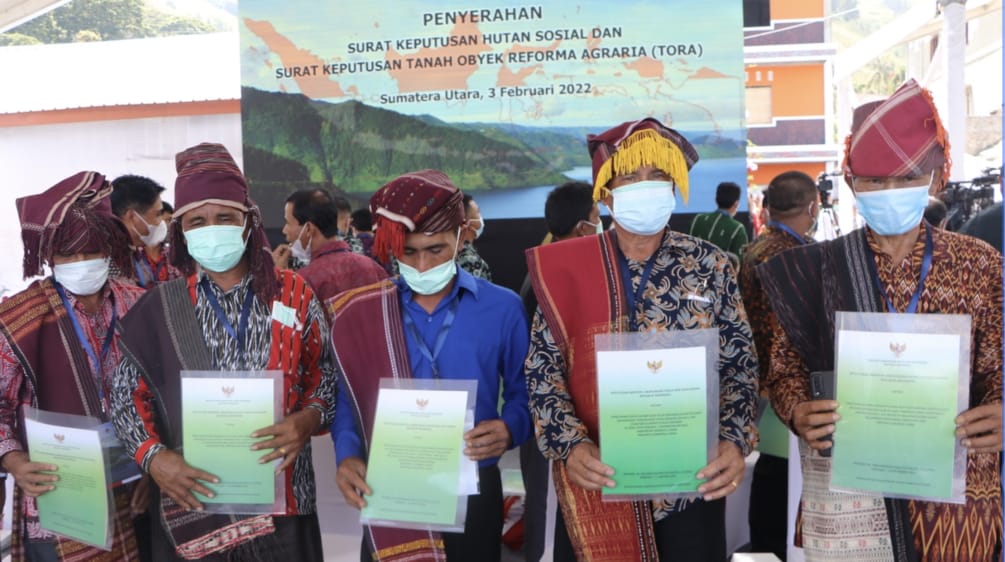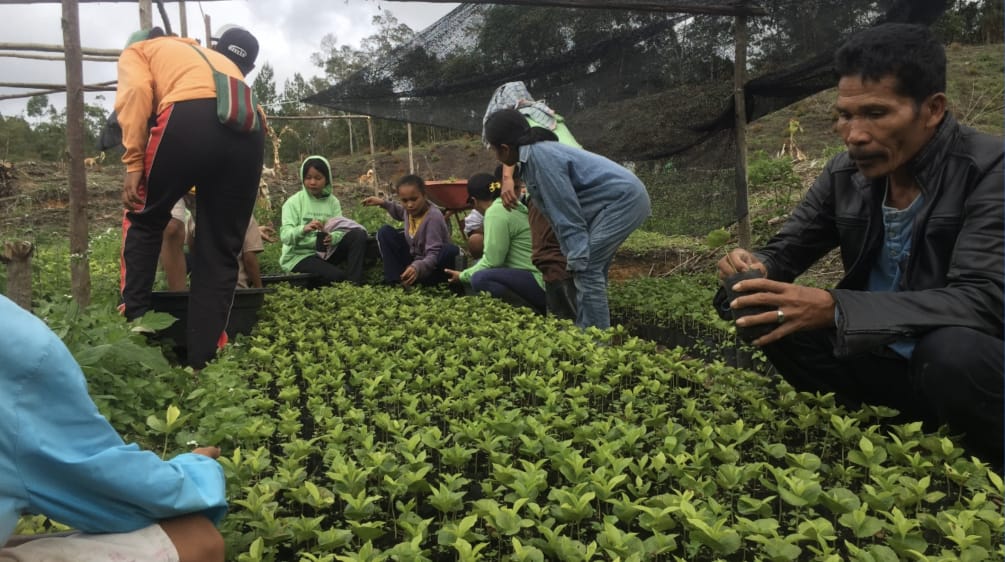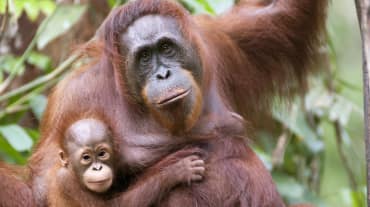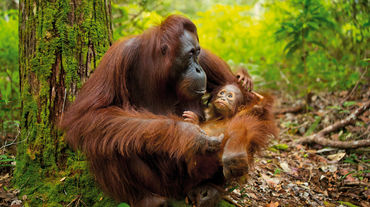Indonesia: New forest on old plantation land – the village of Simenakhenak
Oct 2, 2024
With the help of Rainforest Rescue, the Sumatran village of Simenakhenak is restoring nature to 252 hectares of former eucalyptus plantation land. A new forest of native rainforest trees and coffee bushes is being planted. Project coordinator Hengky Manalu of AMAN Tano Batak reports on the promising results.
Forest, land and village are one
The Batak people of Sumatra are unique: Each clan is closely tied to its village of origin. To find out where someone comes from, just ask their name. You will immediately know the village of the family. Village, land and forest are inseparable parts of the Batak identity. “Huta na mar marga – marga na mar Huta”, the Batak say: a village has a clan and a clan has a village.
This is also the case in the small village of Simenakhenak in the highlands on Lake Toba. This is the home of the Samosir clan – the same name as the famous island in the lake. From the district town of Balige, it is a two-hour motorcycle ride into the mountains with views of the beautiful lake in the distance.
Ompu Raja Martonggo Samosir was the founder of the village, and his descendants still live here. Their livelihoods relied on the resin of the jungle incense trees and growing coffee.
But then Toba Pulp Lestari, a pulp company, came and gradually the forest, the incense trees and coffee plants disappeared. Today, the smell of incense is gone, and pests from the eucalyptus monocultures have infested the remaining coffee plants.
Pulp is our misfortune
Mangapul Samosir, an Indigenous elder from Simenakhenak, tells us about the “legal” land grab by Toba Pulp Lestari, the hard years under the Suharto dictatorship, and the rocky road to official recognition as an Indigenous community.
“Around 1985 and 1986, we didn’t live in our village because there was no school and no market to sell our crops. We moved to the village of Tukko ni Solu, just three kilometers away. We continued to cultivate our fields in Simenakhenak,” he says.
After returning to the village, disaster struck. In 1987, Toba Pulp Lestari, then known as Indorayon, arrived unannounced and cleared the jungle, including the incense trees.
The people of Simenakhenak wanted to protest, but under the authoritarian regime of Suharto, they dared not and resigned themselves to their fate. They had no choice but to watch as their forest was cut down and the tropical timber shipped off to unknown destinations.
After the forest disappeared, the situation of the Indigenous people worsened; they could no longer cultivate their fields and there was no clean water. Instead, they experienced landslides and suffered from the pesticides sprayed on the eucalyptus plantations.
The long road to the Indigenous forest
Then, in 2016, they acted to reclaim their ancestral land. Indonesia considers all forests to be state property and grants concessions to companies, in their case to Toba Pulp Lestari. Since 2013, however, an important ruling by the Constitutional Court has in principle opened up the possibility for recognized Indigenous communities to own and use forests.
But Mangapul Samosir and the other villagers had to overcome many hurdles before they could officially reclaim their forest, from mapping and surveying the historic settlement to filing paperwork with various authorities, from the village government to the ministry in Jakarta.
In a large village meeting, the community decided to become a member of the Alliance of Indigenous People in Batak Land (AMAN Tano Batak).
In 2022, after six long years of hard work, Simenakhenak finally received recognition certificates for 252 hectares of Indigenous forest. They had applied for twice that area. President Joko Widodo personally handed them the certificates in Bakkara, North Sumatra. This cleared the way for them to once again use and protect their land and forest. However, one of the many necessary certificates is still missing: the one from the Toba district office.
But their once dense and beautiful forest has disappeared, partly overgrown with alang-alang grass, partly still eucalyptus plantations of the pulp company. What a challenge!
The new forest is growing
Deep in their collective knowledge of the history and culture of their people, they have internalized the teachings of their ancestors: Take care of the forest!
Indigenous forest titles bring hope, but they are only the beginning. They are linked to the need to maintain or restore the rainforest ecosystem and to live off the forest. For Simenakhenak, this means returning the deforested, herbicide-contaminated and degraded area to forest.
The village community set to work immediately. They identified the ecologically critical places that needed to be healed first. They drew up a plan for the economic opportunities that a young mixed forest could provide.
The goal: to combine ecology and economy so that a new forest can grow and the village can flourish for their children and grandchildren.
The whole village is dedicated to working in the Indigenous forest that is gradually taking shape. The people collect seeds from the existing forest. After two or three months, when the seedlings have grown cotyledons and are strong enough, they are transplanted. Then they are sent to the nursery. After another three months, the seedlings are ready to be planted in the degraded areas.
They are also pinning their hopes on coffee: The older generation used to make a good living from it, sending their children to school and buying things for the household. This is how it should be in the future. A start has been made. The women of the village have already planted 15,000 coffee plants and a few thousand different native jungle trees.
15 hectares of new forest
Fifteen hectares of new forest with coffee and jungle trees is a small area compared to the hundreds of thousands of hectares that have been destroyed for pulp, paper and cellulose. But for the Indigenous people of the village of Simenakhenak in the highlands of Lake Toba, fifteen hectares is a success that gives them hope.
Nature is slowly recovering and the people will soon be able to make a living from the forest again. “Funding by Rainforest Rescue has made it possible to restore the deforested and degraded areas,” writes project coordinator Hengky Manalu in his report.
Rainforest Rescue helped the village community to regain their forest rights. Now we are supporting the village in reforestation and greening. But credit for the success goes to the Indigenous people of Simenakhenak, thanks to their determination, their connection to nature and their work.
Hengky Manalu is convinced: “Simenakhenak is a living example of how Indigenous people can restore the glory of their ancestral lands and build a better future through unity, perseverance and hard work.”
